On Saturday, July 30th, Iseli Nursery partnered with the Portland Japanese Garden to host a hands-on Japanese maple pruning workshop during the final day of the International Japanese Garden Training Center’s “Waza to Kokoro–Hands and Heart” seminar. Led by Sadafumi “Sada” Uchiyama, the Chief Curator of the Portland Japanese Garden, and Maryann Lewis, co-founder of the Aesthetic Pruners Association and certified aesthetic pruner, students from the U.S. and abroad practiced the essential techniques of aesthetic pruning on a variety of maples in the Jean Iseli Memorial Garden. I was lucky enough to have the opportunity to observe this special event, and I’d like to share what I learned with you by offering an introduction to the art of pruning Japanese maples.
Aesthetic pruning is a scientific and creative approach that seeks to bring out the beauty inherent in each individual tree and to integrate it into the garden’s overall design. It goes beyond maintenance pruning, which focuses primarily on structural stability and health, to treat each tree as a work of art. Contemporary aesthetic pruning is rooted in the traditional techniques used in Japanese gardens, where nature is presented in an idealized form. Its aim is to showcase “the essence of the tree,” or to bring out each specimen’s unique character by enhancing its most appealing qualities. Japanese maples are particularly good candidates for this. Opening the canopy to reveal views of the tree’s internal structure not only increases necessary air circulation that combats potential insect and disease issues, but also highlights the contrast between the transitory beauty of the foliage and the enduring strength of the twisting trunk and branches. Skilled pruning accentuates their grace by emphasizing the movement of their fluttering leaves, the elegance of their layered canopy, and the sculptural quality of their form.
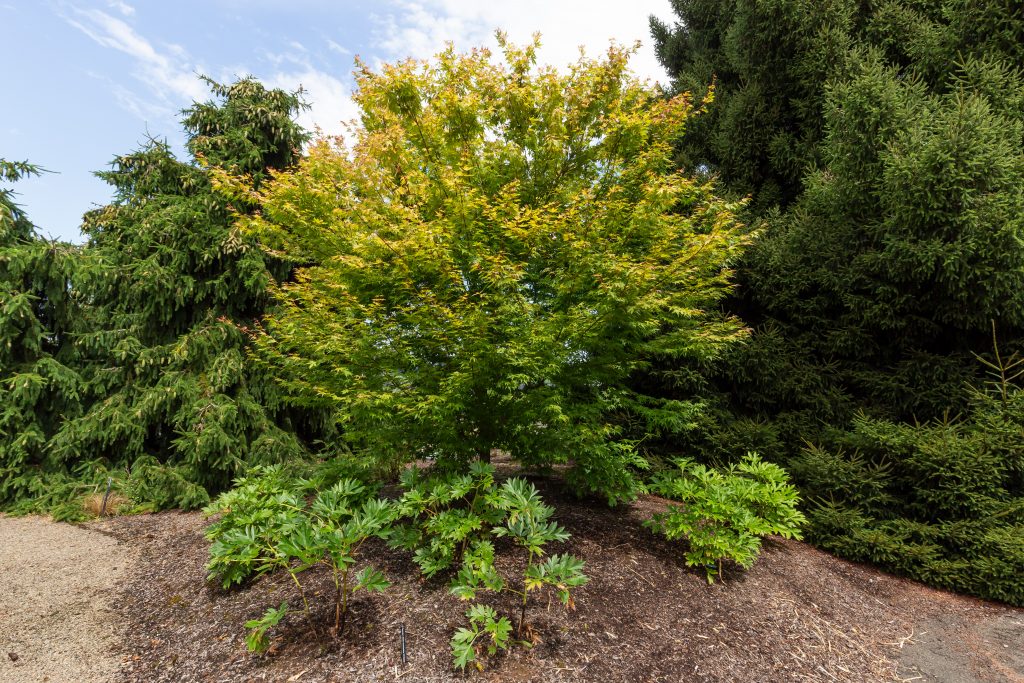
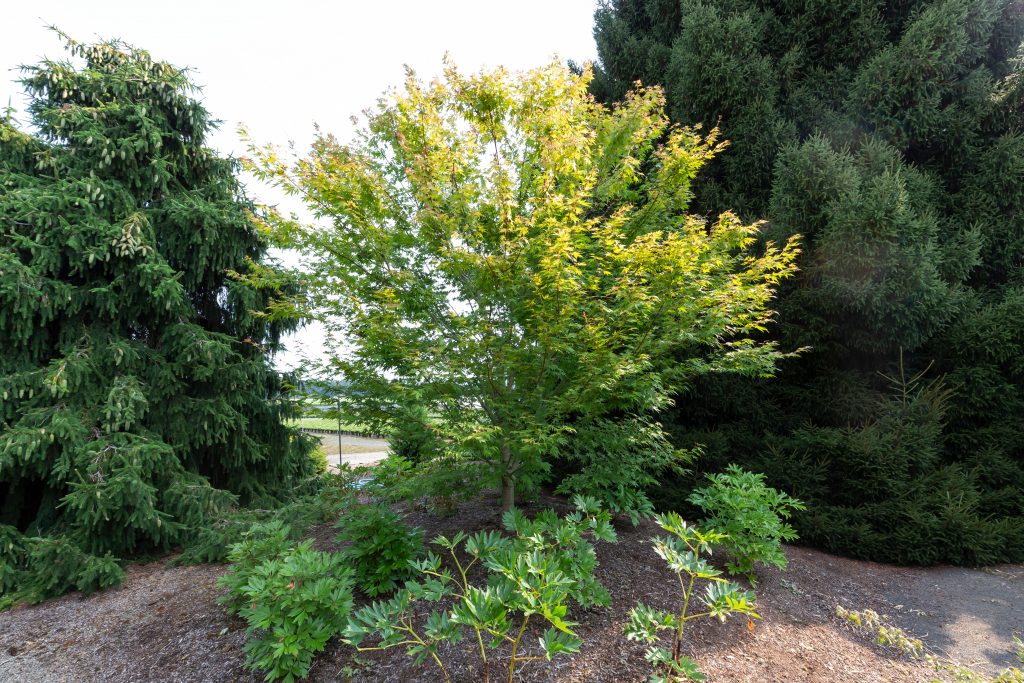
Japanese maples are truly elevated into living art at the hands of seasoned experts like Maryann, Sada, and Tatsuya Hosono, a master gardener (niwashi) and acclaimed landscape architect visiting from Japan. While pruning techniques themselves are simple, the decision making that informs these cuts is not. The process for each tree is unique. The best way to learn is by watching a professional at work so you can observe their decision making process. For example, when Tatsuya demonstrated pruning an upright ‘Fireglow’ Japanese maple, Sada asked everyone to watch quietly. Rather than interrupting Tatsuya’s decision making process with questions, it was best to simply absorb his approach and watch his intuitive plan evolve as he worked.
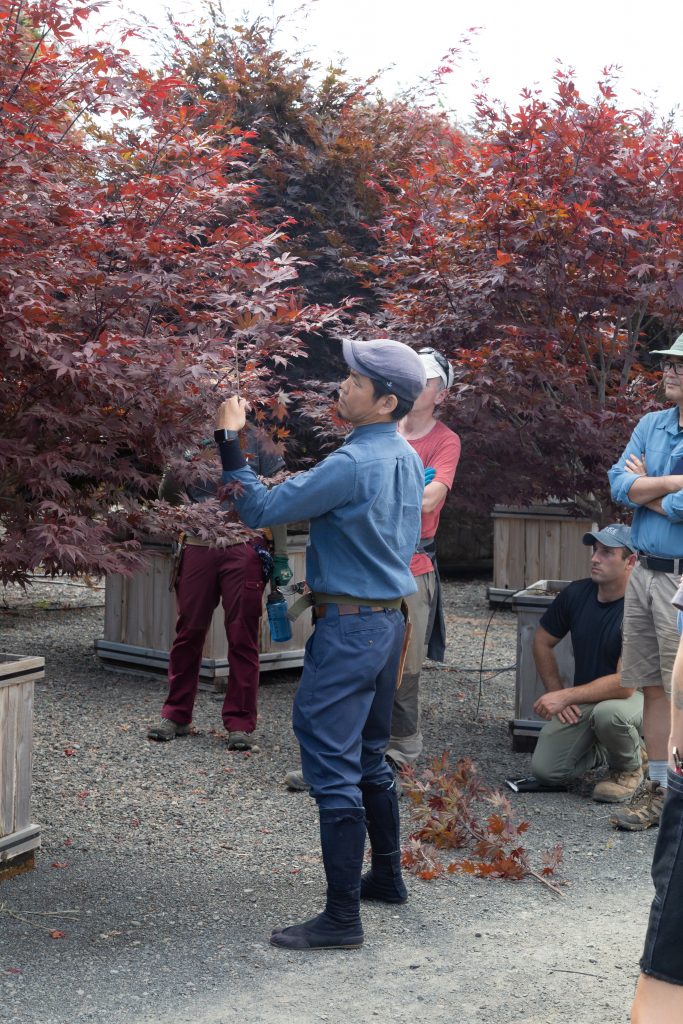
Tackling an overgrown tree might feel like an overwhelming tangle of possibilities, but remember, all these choices do not need to be made at once. As Sada advised, “If you think twice, don’t cut!” It is best to prune often, taking off a small amount of material over multiple seasons. Working with a tree regularly lets you become familiar with it. If you hesitate to remove a branch today, you can always cut it off later. No more than thirty percent of the canopy should be removed at a time, so a major renovation is a long-term project that may take three to five years.
There are three main kinds of pruning cuts. A heading cut removes a branch tip by cutting a portion of a branch back to a quarter inch above a growth point. Cutting directly above leaf nodes stimulates new vegetative growth, so it is best to use this sparingly, preferably on small branches. On Japanese maples, leaf nodes form in pairs on the opposite sides of branches. You can choose the direction of the new growth by rubbing out the bud pointing the wrong way. Thinning cuts remove an entire branch, taking it back to a larger one or to the trunk. Cuts should be made just above the branch collar, the swollen area found at the base of the branch. The branch collar has specialized cells that heal the wound and exclude disease and decay. Reduction cuts shorten branches by taking the end portion back to a lateral branch. Be sure that the diameter of the lateral branch is about one-third of the diameter of the main branch. It must be large and strong enough to maintain the growth energy directed to it, and this ratio creates smoother and less obvious transitions.
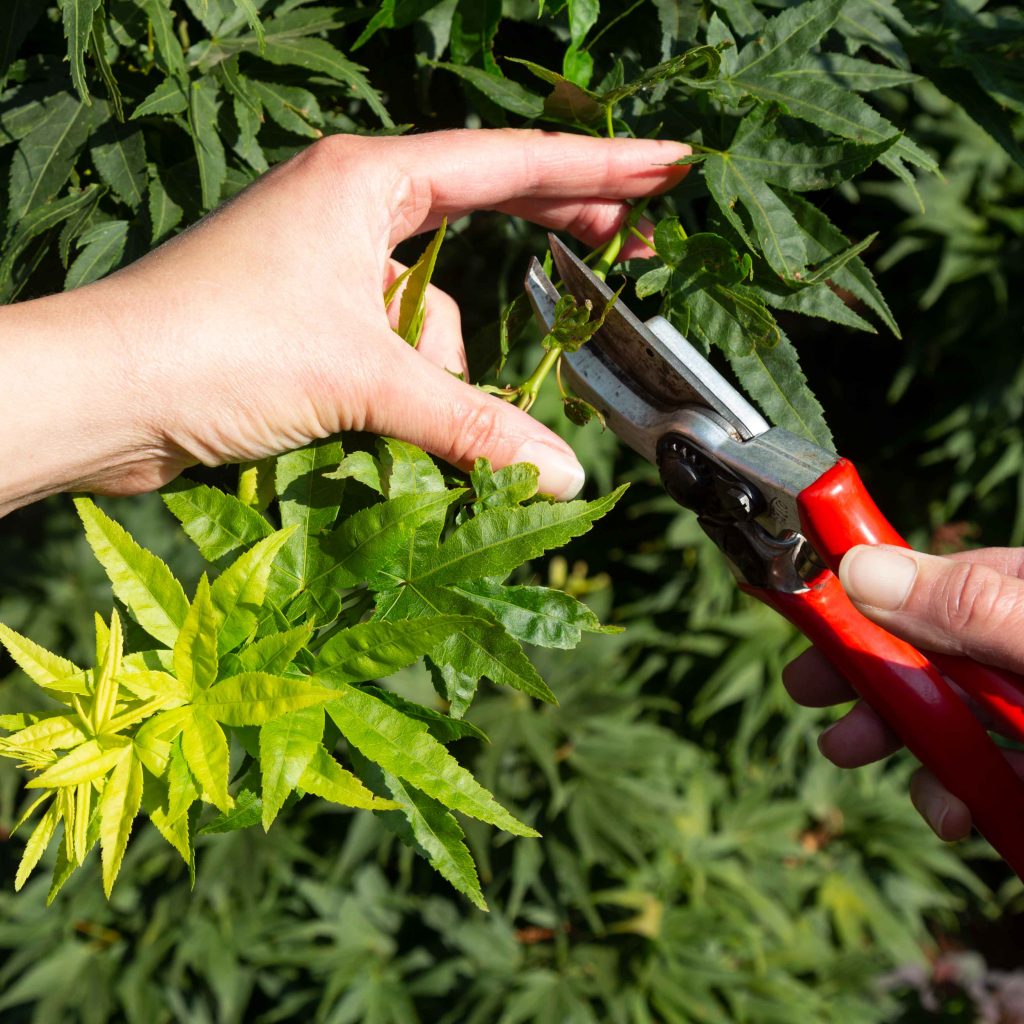
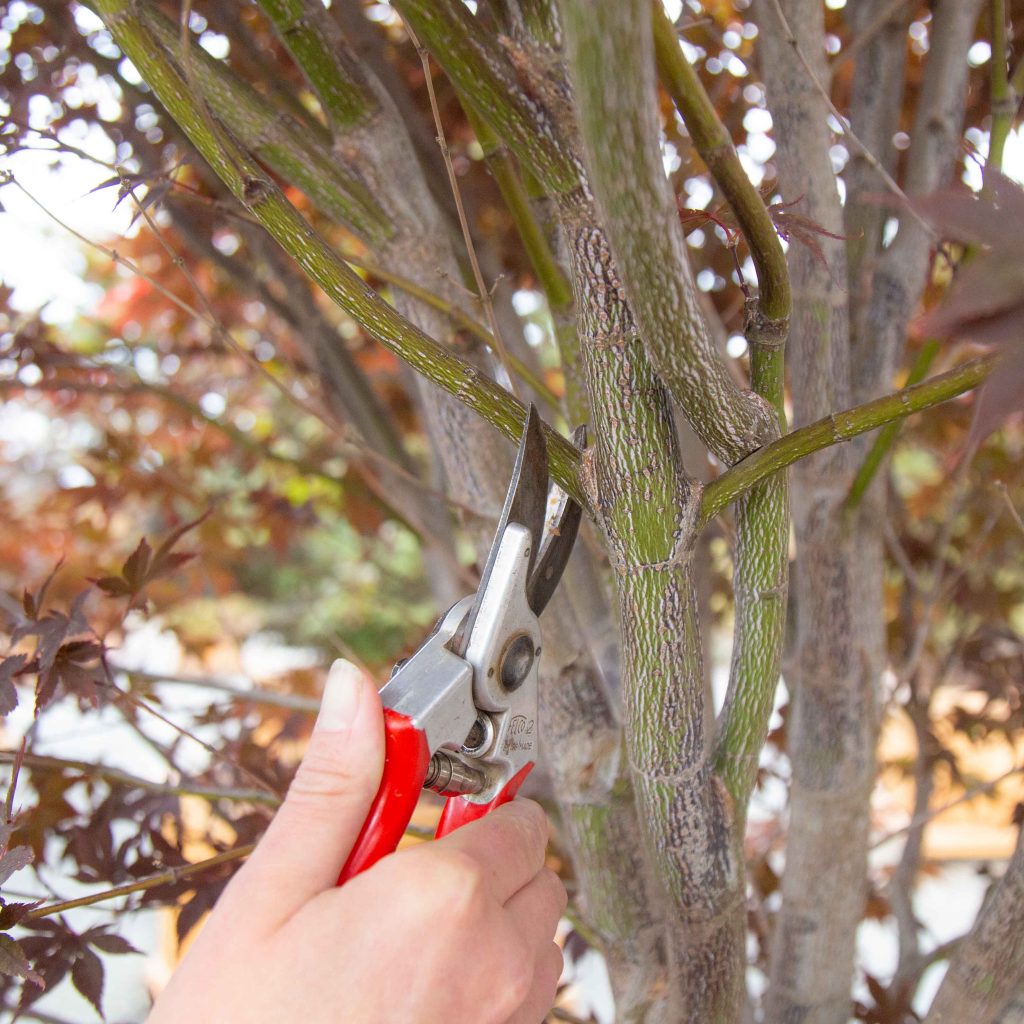
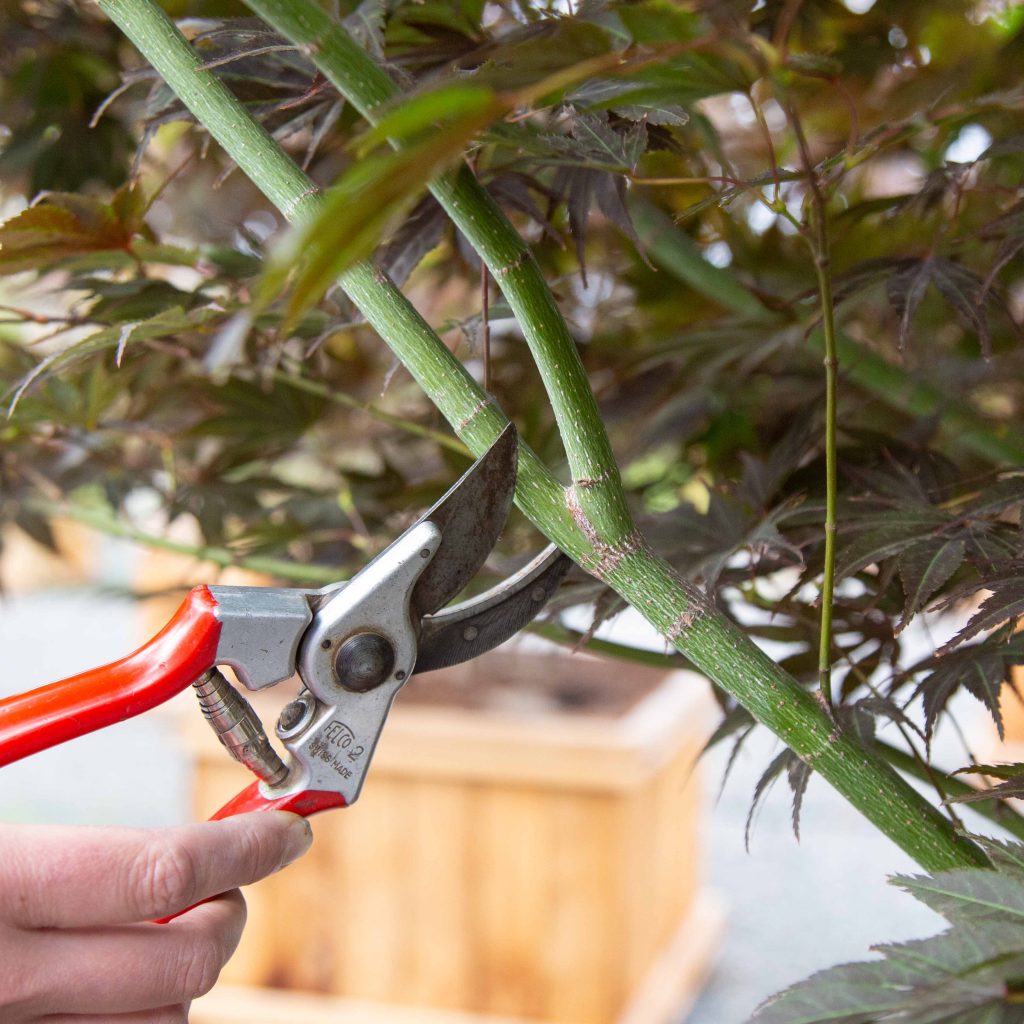
Tools include bypass pruning shears and a handsaw. The tool you choose should be able to cut through the branch easily, so bypass pruners are best for smaller branches with a diameter of less than an inch, and a folding handsaw is better for larger branches. A three-legged orchard ladder will help you safely reach the upper canopy.
Timing is also important. Dead and diseased branches can be removed at any time. Winter is the best time to remove larger branches. During dormancy, large wounds are more likely to heal without oozing sap that could attract insects or disease. Summer, starting in late June once the spring growth push has passed, is an ideal time for fine pruning. It’s easiest to address congestion issues when branches are fully leafed out. However, exposing inner branches to full sun on a hot day can damage tender bark, so aim for cooler days and take off small amounts of material at a time. Especially when pruning weeping maples, be careful not to thin the top of the canopy too much because the branches at the crown burn easily.
The first step to pruning any Japanese maple is to evaluate it. Examine the tree itself and then consider it within the context of its surroundings. Identify it. What species is it? Assess its health and care. Is it getting adequate light, water, and nutrients? Does it have insect or disease issues? Can you see a healthy root flare? Is it young or old? Has it reached its mature size, or is it actively growing? Consider the form of the tree. Does it have a distinct leader and well distributed main scaffold branches? Is the canopy balanced? What do you like about it? Then expand your vision to look at it in relation to the rest of the garden. What role does it play? How does it interact with both the plants and people who share this space? After gathering as much information as you can, develop a plan. You don’t need to have a fully formed, step-by-step process in mind before you begin, but you should be clear on the problems you’d like to correct and, more importantly, the good qualities that you’d like to emphasize.
Now, clean out the tree by removing the “five D’s:” branches that are dead, dying, damaged, diseased, and deformed. Deformed branches include those that are crossing or rubbing against each other. If there are many large, congested branches, you will need to gradually remove them over multiple seasons. Getting rid of the branches that obviously need to go makes it easier to see the tree’s positive qualities.
You can use thinning to emphasize Japanese maples’ best attributes: their elegant, fan-like sprays of secondary branches, and their twisting main branches. Choose the best branches as the ones to keep. Ideal branches transition gracefully in diameter from base to tip. Tree growth follows a coarse to fine pattern. The oldest branches and the base of the trunk are the widest, and younger branches at the top of the plant and the ends of branch tips are the narrowest. Maintaining this proportionality through the overall form of the tree makes it look balanced. As you thin, strategically preserve branches that have this flow and grow upwards and outwards from the trunk. Opening up the canopy to expose more of the tree’s internal structure helps make it look full without being crowded. Removal also redirects new growth in the places you choose. Letting more light into the center and lower branches of a mature tree spurs new growth that will create the look of greater depth and help to balance its form. The right cuts can encourage an underdeveloped branch to grow and fill in a bare spot.
Articulate the maple’s fan-like branching pattern by separating these sprays into parallel layers. Remove undesirable secondary branches that cross through these layers or jut out in the wrong direction. If two branches are growing parallel to each other, take out the redundant branch. Keep branches that grow out at a wider angle from the parent branch, because the wider the angle, the stronger this connection will be. Keep moving around the tree as you work and be sure to step back and look at it often so that you can be sure you are building an overall canopy with horizontal swaths of branches.
Shaping for Japanese and Asian maples is species specific. In the workshop, our experts worked on a variety of trees, including two weeping cutleaf Japanese maples, a hybrid Asian maple, and two kinds of upright Japanese maples using the shaping techniques appropriate for their different forms.
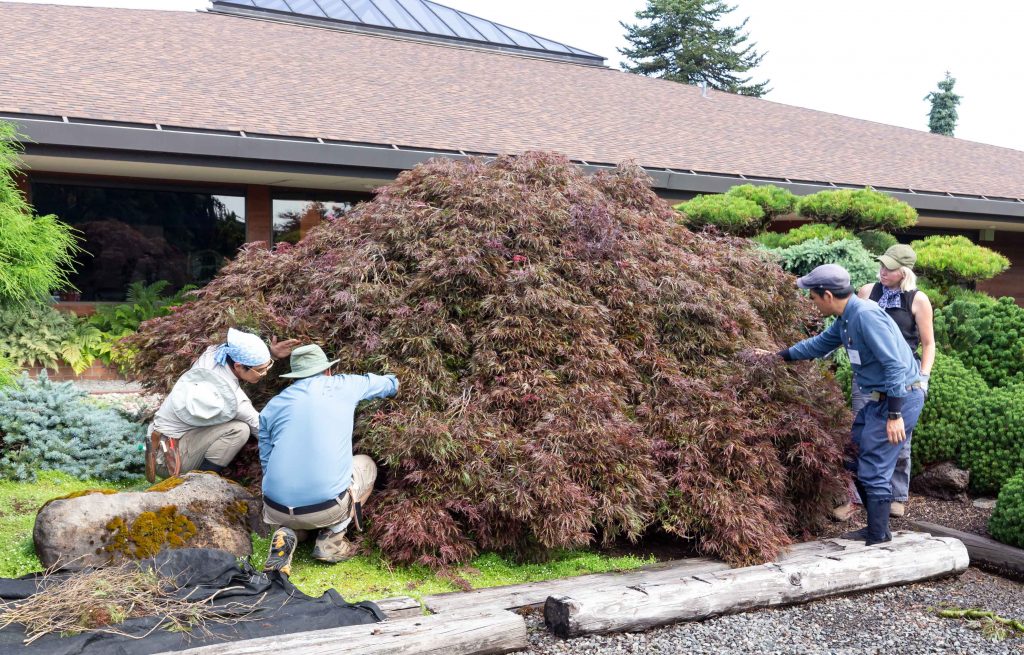
It was no small task to tackle the two huge, shaggy, forty-year-old cutleaf Japanese maples (Acer palmatum var. dissectum ‘Inaba Shidare’) in front of our office. As Maryann began to work, taking off one small branch at a time, it looked like she might be swept away by their cascading red foliage. After her excavation started to make the inside of the tree more visible, she thinned by following the layered branching structure, selecting for those that flowed out and down. Finally, when she found places where a natural gap in the branches started to appear, she expanded these to create windows. As soon as she created the first gap, the canopy almost seemed to inflate, dramatically gaining visual volume. She rotated around the entire tree, taking care that these openings appeared to be irregular but were balanced. A window at the front of the canopy should not follow directly through to one in the back; instead, they should be spaced unevenly, so the eye must take a more complicated path. Creating these viewpoints defines spaces as foreground, midground, and background, which not only brings out dimension in the tree itself but expands the viewer’s perspective, connecting the tree with the rest of the garden.
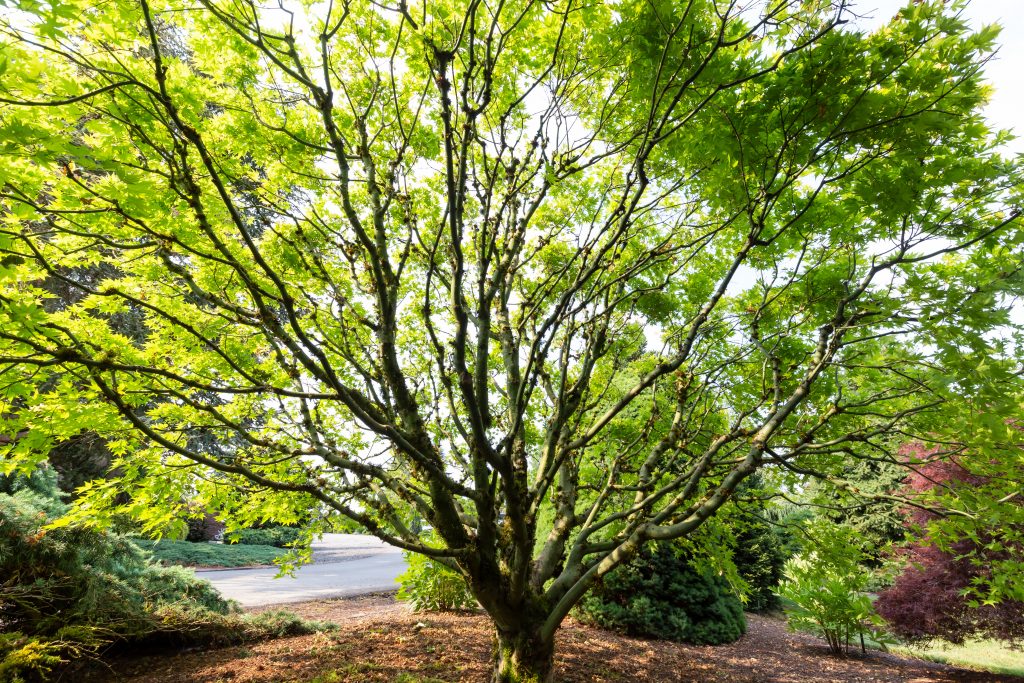
These design concepts of asymmetrical balance and visual depth also apply to shaping upright Japanese maples. At the end of the workshop, the students applied everything they’d learned to help Sada and Tatsuya prune an ‘Orange Dream’ Japanese maple (Acer palmatum ‘Orange Dream’). This rounded specimen is around ten feet tall and had been awkwardly cut back where it had grown into a pathway. Students were challenged to develop a pruning plan that would bring the natural form of this tree, which has many low branches and a shrubby shape, into harmony with its environment. Decongesting its dense canopy brought a much needed feeling of openness to the space and offset the feeling of enclosure compounded by the large conifer on the opposite side of the path. Thinning unnecessary branches throughout the canopy made the area that had to be cut back much less noticeable. And, while the tree’s bright chartreuse color had been its one defining quality, opening the canopy revealed an intricate inner structure of upward arching, undulating branches radiating from a strong, straight leader, offering so much more to see.
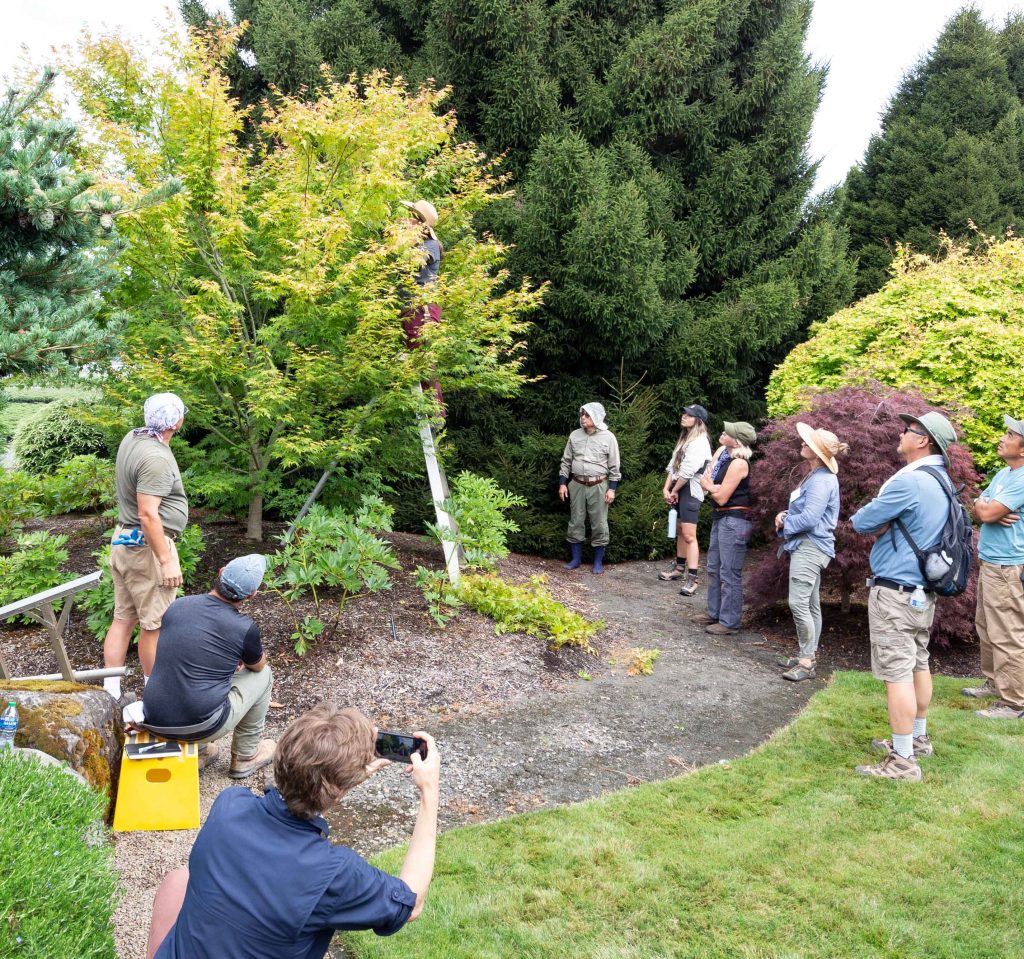
Finally, Maryann pruned a ‘First Flame’ hybrid Asian maple from our Pacific Rim collection to demonstrate how important it is to allow each species’ specific qualities to guide your work. Compared with Japanese maples, the ‘First Flame’ has primary branches that grow at more sharply upright angles and its secondary branches are spaced further apart from each other. Working with the tree’s unique form, after decluttering the canopy, she thinned the clusters of small branches at the top by cutting back the longer ones, which softened the contrast between the bushy foliage and the long branches. This species has a less formal look than the classic Acer palmatum, so she adjusted her approach to match its more relaxed growth habit. Now that this bold and vigorous tree has been brought into harmony with its environment, the contrast between its bright yellow green foliage and the green Cryptomeria behind it has made this corner of the garden more appealing. Its details, like the orange-red tipped new growth at the top of the crown, stand out beautifully.
Aesthetic pruning is not a linear process. Beyond the basic steps of evaluation, cleaning out, and shaping, its application depends on the pruner’s artistic vision, the tree’s unique qualities, and the context of the garden they both inhabit. This creative process is collaborative and organic. As the gardener guides the evolving form of the tree, a relationship grows between the two of them. Pruning the versatile and adaptable Japanese maple, which can thrive even in the smallest city yard, offers a special opportunity for the dedicated home gardener to interact with nature in a uniquely intimate way.
For more information:

You must be logged in to post a comment.